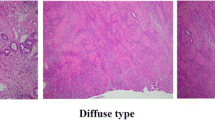Abstract
Background
The clinicopathological features of mixed-type (MT) early gastric cancer (EGC) according to Lauren’s classification remain uninvestigated. This study aimed to clarify the clinicopathological features of MT EGC, particularly in relation to lymph node metastasis (LNM) and long-term survival.
Methods
This study included 5309 patients who underwent gastrectomy for EGC. The clinicopathological features, LNM, and long-term outcomes of patients with MT carcinomas were compared with those of patients with intestinal-type (IT) and diffuse-type (DT) cancers. Furthermore, we evaluated the predictors of LNM in each Lauren classification subgroup.
Results
Patients with MT carcinomas were likelier to have larger tumors, submucosal invasion, lymphovascular invasion, and LNM than those with IT or DT carcinomas. Multivariate logistic regression analysis revealed that the Lauren classification was a significant predictor of LNM (P < 0.001). The significant predictors of LNM in MT carcinomas were female sex, greater tumor size, presence of submucosal invasion, and lymphovascular invasion. However, the overall survival of patients with MT carcinoma was not significantly different from that of patients with IT or DT carcinomas (P = 0.104).
Conclusions
The presence of MT EGC carries a higher risk of LNM compared with the presence of IT or DT carcinomas. Therefore, MT carcinomas should be managed with gastrectomy that includes lymph node dissection instead of endoscopic resection.


Similar content being viewed by others
References
Miyamae M, Komatsu S, Ichikawa D, et al. Histological mixed-type as an independent risk factor for nodal metastasis in submucosal gastric cancer. Tumour Biol. 2016;37:709–14.
Pyo JH, Lee H, Min BH, et al. Long-term outcome of endoscopic resection vs. surgery for early gastric cancer: a non-inferiority-matched cohort study. Am J Gastroenterol. 2016;111:240–9.
Zheng H, Takahashi H, Murai Y, et al. Pathobiological characteristics of intestinal and diffuse-type gastric carcinoma in Japan: an immunostaining study on the tissue microarray. J Clin Pathol. 2007;60:273–7.
Berlth F, Bollschweiler E, Drebber U, et al. Pathohistological classification systems in gastric cancer: diagnostic relevance and prognostic value. World J Gastroenterol. 2014;20:5679–84.
Chen YC, Fang WL, Wang RF, et al. Clinicopathological variation of Lauren classification in gastric cancer. Pathol Oncol Res. 2016;22:197–202.
Zheng HC, Li XH, Hara T, et al. Mixed-type gastric carcinomas exhibit more aggressive features and indicate the histogenesis of carcinomas. Virchows Arch. 2008;452:525–34.
Stelzner S, Emmrich P. The mixed type in Lauren’s classification of gastric carcinoma. Histologic description and biologic behavior. Gen Diagn Pathol. 1997;143:39–48.
Lauren P. The two, histological main types of gastric carcinoma: diffuse and so-called intestinal-type carcinoma. an attempt at a histo-clinical classification. Acta Pathol Microbiol Scand. 1965;64:31–49.
Ronellenfitsch U, Lippert C, Grobholz R, et al. Histology-based prediction of lymph node metastases in early gastric cancer as decision guidance for endoscopic resection. Oncotarget. 2016;7:10676–83.
Bowman FT, Carneiro F, Hruban RH, editors. Classification of tumours of the digestive system. Lyon: International Agency for Research on Cancer; 2010.
Edge SB, Byrd DR, Compton CC, Fritz AG, Greene FL, Trotti A III, editors. AJCC cancer staging manual. 7th ed. New York: Springer; 2010.
Japanese Gastric Cancer Association. Japanese classification of gastric carcinoma: 3rd English edition. Gastric Cancer. 2011;14:101–12.
Bamboat ZM, Tang LH, Vinuela E, et al. Stage-stratified prognosis of signet ring cell histology in patients undergoing curative resection for gastric adenocarcinoma. Ann Surg Oncol. 2014;21:1678–85.
Hanaoka N, Tanabe S, Mikami T, et al. Mixed-histologic-type submucosal invasive gastric cancer as a risk factor for lymph node metastasis: feasibility of endoscopic submucosal dissection. Endoscopy. 2009;41:427–32.
Komatsu S, Ichikawa D, Miyamae M, et al. Histological mixed-type as an independent prognostic factor in stage I gastric carcinoma. World J Gastroenterol. 2015;21:549–55.
Kozuki T, Yao T, Nakamura S, et al. Differences in p53 and cadherin-catenin complex expression between histological subtypes in diffusely infiltrating gastric carcinoma. Histopathology. 2002;41:56–64.
Shimizu H, Ichikawa D, Komatsu S, et al. The decision criterion of histological mixed type in “T1/T2” gastric carcinoma–comparison between TNM classification and Japanese classification of gastric cancer. J Surg Oncol. 2012;105:800–4.
Takizawa K, Ono H, Kakushima N, et al. Risk of lymph node metastases from intramucosal gastric cancer in relation to histological types: how to manage the mixed histological type for endoscopic submucosal dissection. Gastric Cancer. 2013;16:531–6.
Yoon HJ, Kim YH, Kim JH, et al. Are new criteria for mixed histology necessary for endoscopic resection in early gastric cancer? Pathol Res Pract. 2016;212:410–4.
Kim HM, Pak KH, Chung MJ, et al. Early gastric cancer of signet ring cell carcinoma is more amenable to endoscopic treatment than is early gastric cancer of poorly differentiated tubular adenocarcinoma in select tumor conditions. Surg Endosc. 2011;25:3087–93.
Pyo JH, Shin CM, Lee H, et al. A risk-prediction model based on lymph-node metastasis for incorporation into a treatment algorithm for signet ring cell-type intramucosal gastric cancer. Ann Surg. 2016. doi:10.1097/SLA.0000000000001602.
Kang HY, Kim SG, Kim JS, et al. Clinical outcomes of endoscopic submucosal dissection for undifferentiated early gastric cancer. Surg Endosc. 2010;24:509–16.
Tahara E. Genetic pathways of two types of gastric cancer. IARC Sci Publ. 2004:327–49.
Park SY, Kook MC, Kim YW, et al. Mixed-type gastric cancer and its association with high-frequency CpG island hypermethylation. Virchows Arch. 2010;456:625–33.
Author information
Authors and Affiliations
Corresponding authors
Ethics declarations
Conflict of interest
The authors declare that they have no conflict of interest.
Additional information
J. H. Pyo and H. Lee contributed equally to this work.
Rights and permissions
About this article
Cite this article
Pyo, J.H., Lee, H., Min, BH. et al. Early gastric cancer with a mixed-type Lauren classification is more aggressive and exhibits greater lymph node metastasis. J Gastroenterol 52, 594–601 (2017). https://doi.org/10.1007/s00535-016-1254-5
Received:
Accepted:
Published:
Issue Date:
DOI: https://doi.org/10.1007/s00535-016-1254-5




